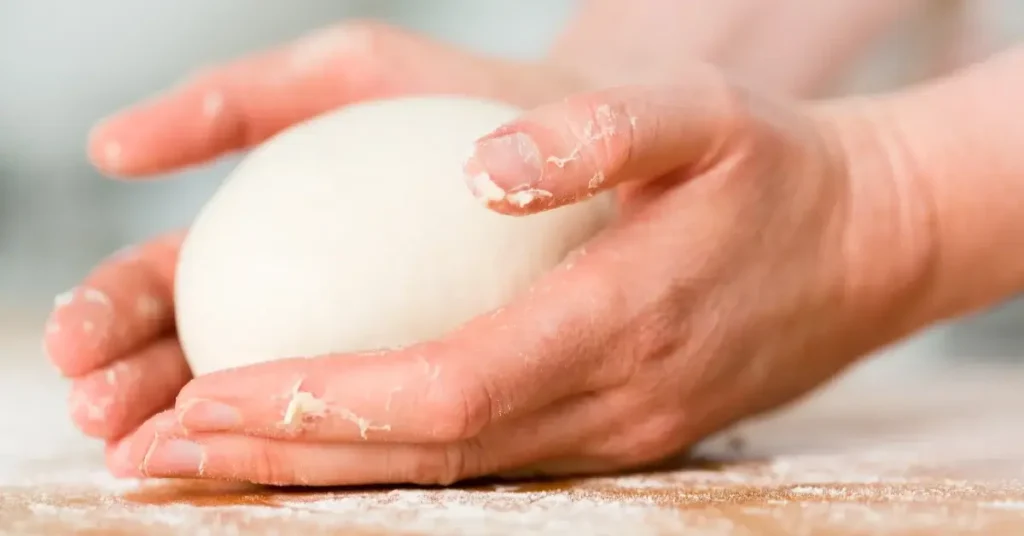Ever wondered how to make sourdough sandwich bread that’s soft, tangy, and goes with any filling? You’re in the right place! This recipe is your go-to for making a delicious homemade bread. Using simple ingredients and a unique, fermented taste, it’s a hit with everyone who tries it.
Key Takeaways
- Discover the secret to creating soft, tangy sourdough sandwich bread at home.
- Learn how to make a sourdough starter from scratch for maximum flavor.
- Explore essential equipment and tips for baking the perfect loaf every time.
- Uncover the best ingredients and step-by-step instructions for an easy sourdough sandwich bread recipe.
- Enjoy delicious variations and storage tips to make the most of your homemade sourdough.
What Makes Sourdough Sandwich Bread Delicious?
Sourdough sandwich bread stands out due to its unique mix of flavors and textures, making it far superior to regular store-bought loaves.
Simple, Real Ingredients
Unlike mass-produced breads that rely on artificial additives, this bread is made with wholesome, natural ingredients. The recipe includes all-purpose flour, warm water, active sourdough starter, butter, sugar, and salt—all coming together to create a loaf that’s both nutritious and flavorful.
Tangy, Fermented Flavor
The sourdough starter is the star ingredient. It undergoes a natural fermentation process, giving the bread a distinct tangy flavor that’s hard to replicate with commercial yeasts. This process also makes the bread easier to digest by breaking down the grains.
Soft, Fluffy Texture
The slow rise and gentle kneading develop the gluten structure, resulting in a tender, pillowy texture that is characteristic of a perfect sourdough sandwich bread. This texture makes the bread ideal for a variety of uses—whether you’re making sandwiches, toast, or simply enjoying a slice with butter. The gluten network formed during kneading traps air bubbles, which expand during baking, giving the bread its soft, airy crumb. Additionally, the long fermentation process helps to break down the starches and proteins in the flour, making the bread not only fluffier but also more digestible.
Pro Tip: For an even softer texture, consider adding a bit of milk or milk powder to the dough, which can enhance moisture retention and crumb softness.
How to Make a Sourdough Starter
Creating a sourdough starter from scratch is simpler than it seems. Here’s how to do it:
- Day 1: In a clean jar, mix 1 cup of all-purpose flour with 1 cup of warm water (around 80°F). Stir until well combined. Cover the jar loosely and let it sit at room temperature for 24 hours.
- Learn more about sourdough starters from King Arthur Baking.

- Day 2-7: After 24 hours, discard half of the starter. Add ½ cup of flour and ½ cup of warm water, mixing well. Repeat this process daily for the next 5-7 days. By day 3 or 4, you should start seeing bubbles, a sign that your starter is becoming active.

- Day 8: When your starter doubles in size within 8-12 hours of feeding, it’s ready to use. This means it has enough strength to make your sourdough bread rise effectively.

Tip: A healthy, active starter is essential for great sourdough bread. If your starter isn’t doubling, give it a few more days, and make sure it’s kept in a warm environment.
Essential Equipment for Sourdough Sandwich Bread
Having the right equipment ensures your sourdough sandwich bread turns out perfectly every time. Here’s what you’ll need:
Mixer Options: Stand Mixer or Hand Kneading
- Stand Mixer: A stand mixer with a dough hook attachment makes kneading easier and more consistent.
- Hand Kneading: If you prefer a hands-on approach, kneading by hand allows you to feel the dough’s texture and control gluten development.
Loaf Pans for Optimal Rise
- Standard Loaf Pan (8.5″ x 4.5″): Using the right loaf pan is crucial. This size pan helps achieve an optimal rise and gives the bread a classic sandwich loaf shape.
Proofing Mat for Controlled Temperature
- Proofing Mat: Maintaining the correct temperature during proofing is key. A proofing mat or box helps create a consistent environment, ensuring your dough rises properly.
| Equipment | Importance |
|---|---|
| Stand Mixer | Effortless kneading of the dough |
| Loaf Pan (8.5″ x 4.5″) | Achieves optimal rise and classic sandwich loaf shape |
| Proofing Mat | Maintains consistent temperature for proper dough rising |

Ingredients for Sourdough Sandwich Bread
The secret to a delicious sourdough sandwich bread lies in its ingredients. This recipe uses a simple yet carefully selected list of high-quality items.
Key Ingredients:
- Active Sourdough Starter: ¼ cup (50 g) – Provides the signature tangy flavor and leavening.
- All-Purpose Flour: 4 cups + 2 tbsp (500 g) – Builds the structure and texture of the bread.
- Water: 1 cup + 2 ½ tbsp (275 g) – Hydrates the dough and facilitates gluten development.
- Butter: 4 tbsp (60 g) – Adds richness and a soft, tender crumb.
- Honey: 1 tbsp – Enhances the bread’s natural sweetness.
- Salt: 2 tsp (10 g) – Balances the flavors and controls yeast fermentation.
Pro Tip: Use high-quality, fresh ingredients to ensure the best possible flavor and texture in your bread.
Step-by-Step Instructions for Soft Sourdough Sandwich Bread
Making sourdough sandwich bread at home is easier than it seems. Just follow these steps to achieve a perfect soft, tangy loaf that’s great for any filling.
1. Kneading the Dough
- Mix Ingredients: In a large bowl, combine all-purpose flour, salt, and sugar (if using). Create a well in the center and add your active sourdough starter, warm water, and melted butter.
- Knead: Mix until a shaggy dough forms, then transfer it to a floured surface. Knead for about 10 minutes until the dough becomes smooth and elastic.

2. Bulk Fermentation (First Rise)
- First Rise: Place the dough in a greased bowl, cover it, and let it rise at room temperature for 6-8 hours. The dough should double in size during this time.
3. Shaping the Loaf

- Shape: After the first rise, gently punch down the dough to release excess air. Shape the dough into a rectangle, then roll it tightly to fit into a standard loaf pan.
4. Final Proof (Second Rise)
- Second Rise: Cover the shaped loaf and let it rise again for 4-6 hours, or until it has nearly doubled in size.
5. Baking the Sourdough Sandwich Bread
- Bake: Preheat your oven to 400°F (200°C). Place the loaf in the oven and bake for 40-50 minutes until the crust is golden brown and the internal temperature reaches at least 195°F (91°C).

- Finish: Brush the top with melted butter immediately after baking for a shiny crust.
Quick Tip: If your bread browns too quickly, cover it with aluminum foil during the last 15 minutes of baking.
Tips for Perfect Sourdough Sandwich Bread
Adjusting for Temperature and Starter Activity
The temperature and your sourdough starter’s activity level greatly impact the bread’s rise and texture. Here’s how to adjust:
- Proof Time: Rising times vary with temperature. For example, at 70°F, the dough may take 1-2 hours to rise. In cooler environments, it could take longer.
- Starter Strength: If your starter is very active, consider using less or adjusting fermentation times, as the dough may rise faster.
- Baking Temperature: Adjust the oven temperature slightly based on how your dough rises to avoid over-proofing.
Pro Tip: Monitor your dough closely and be ready to adjust based on your kitchen’s temperature and your starter’s activity.
Storage and Freezing Sourdough Bread
Storing Sourdough Sandwich Bread
- Room Temperature: Keep your bread at room temperature for up to a week. Store it in a paper or cloth bag or wrap it loosely in foil to maintain its crust and freshness.
- Check out more storage tips from The Perfect Loaf.
Freezing Sourdough Bread
- Freezing Whole Loaf: Cool the loaf completely, then wrap it tightly in plastic wrap or foil. Place it in a freezer bag or airtight container and freeze for up to 6 months.
- Freezing Slices: Slice the bread, lay the slices on a baking sheet, and freeze them. Once frozen, transfer the slices to an airtight freezer bag. This method allows you to thaw only what you need.
Quick Tip: Thaw frozen bread at room temperature or pop slices directly into the toaster.
Variations and Substitutions
The basic sourdough sandwich bread recipe is versatile, allowing for variations to suit different tastes and dietary needs.
Whole Wheat Sourdough Sandwich Bread
- Healthier Option: Substitute up to 50% of the all-purpose flour with whole wheat flour for a heartier loaf. The bread will retain its soft texture while offering more nutrition.
Dairy-Free Sourdough Sandwich Bread
- Dairy-Free Option: Replace butter with plant-based alternatives like coconut oil or margarine. Substitute milk with almond, oat, or soy milk to maintain a moist and tender crumb without dairy.
How to Make the Most of Your Sourdough Sandwich Bread
Sourdough sandwich bread is incredibly versatile and pairs well with various dishes. Here are some ideas:
- For a quick and healthy meal: Pair your homemade bread with some thinly sliced chicken breast. Check out thin sliced chicken breast recipes for ideas on how to prepare a quick and nutritious sandwich filling.

- Looking for something simple yet satisfying? Try using this bread as a base for 4-ingredient chicken breast recipes to create a delicious and easy meal.

Conclusion
Baking the perfect sourdough sandwich bread at home is a rewarding experience. This recipe guides you through making a soft, tangy loaf that’s perfect for any filling—from grilled cheese to fresh veggies.
By using high-quality ingredients, following precise steps, and making small adjustments based on your environment, you can enjoy bakery-quality sourdough bread at home. Whether you’re a novice or an experienced baker, this sourdough sandwich bread recipe is sure to impress and become a staple in your kitchen.
FAQs
What makes sourdough sandwich bread so delicious?
Sourdough sandwich bread is beloved for its simple, real ingredients and tangy, fermented flavor. The use of an active sourdough starter gives it a unique taste and texture, making it a flavorful and nutritious choice.
How do I make a sourdough starter?
A sourdough starter is made by fermenting flour and water over several days. It involves daily feeding until the mixture becomes bubbly and active, ready to leaven your bread.
What equipment do I need to make sourdough sandwich bread?
To make sourdough sandwich bread, you’ll need a stand mixer or the ability to knead by hand, a standard loaf pan, and a proofing mat to ensure the dough rises properly.
What ingredients are used in sourdough sandwich bread?
The key ingredients include all-purpose flour, butter, sugar, salt, and an active sourdough starter. Quality ingredients are crucial for achieving the best flavor and texture.
How do I adjust the recipe for different temperatures and starter activity?
Adjustments may be necessary based on your kitchen’s temperature and the activity level of your starter. These factors affect proofing times and the final texture of your bread.
How do I store and freeze sourdough sandwich bread?
Store the bread at room temperature in a paper or cloth bag for up to a week. For longer storage, freeze the bread whole or sliced using airtight packaging to maintain freshness.


15 thoughts on “Sourdough Sandwich Bread: Soft, Tangy & Easy Recipe”